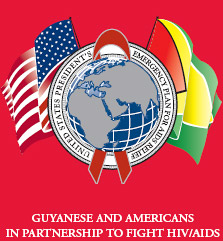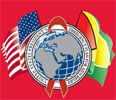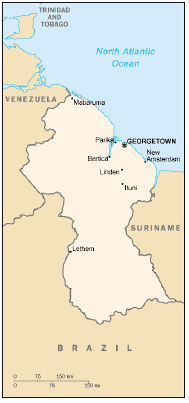| 2008 Country Profile: Guyana PDF version PDF version

 |
|
2008 Country Profile: Guyana
National HIV prevalence rate among adults (ages 15-49): 2.5 percent1
Adults and children (ages 0-49) living with HIV at the end of 2007: 13,0001
AIDS deaths (adults and children) in 2007: <1,0001
AIDS orphans at the end of 2007: Unknown1
Guyana is one of PEPFAR’s 15 focus countries, which collectively represent approximately 50 percent of HIV infections worldwide. Under PEPFAR, Guyana received more than $12 million in Fiscal Year (FY) 2004, nearly $19.4 in FY 2005, more than $21.7 million in FY 2006, and $28.4 million in FY 2007 to support comprehensive HIV/AIDS prevention, treatment and care programs. PEPFAR is providing $23.8 million in FY 2008. | |
Recognizing the global HIV/AIDS pandemic as one of the greatest health challenges of our time, President George W. Bush announced the President’s Emergency Plan for AIDS Relief (PEPFAR) in 2003 — the largest international health initiative in history by one nation to address a single disease. The United States is changing the paradigm for development, rejecting the fl awed “donor-recipient” mentality and replacing it with an ethic of true partnership. These partnerships are having a global impact and transforming the face of our world today.
Partnership to Fight HIV/AIDS
Between 1988 and 2000, the Government of Guyana was the main source of financial support for HIV/AIDS programs. Since then, external funding, principally from PEPFAR, has surpassed domestic sources of funding by approximately 50 percent.
The U.S. Government (USG) response under PEPFAR in Guyana aligns closely with the nation’s own response to the epidemic and focuses on prevention due to the early stage of the epidemic.
Key PEPFAR-supported activities include:
- Strengthening the surveillance system to produce information to inform the design of interventions for HIV prevention and care programs;
- Reducing the risk of, and vulnerability to, HIV infection through targeted prevention services among high-risk populations;
- Supporting a network of non-governmental, community-based and faith-based organizations across the country to provide prevention and care services;
- Supporting the expansion of prevention of mother-to-child HIV transmission, counseling and testing, and treatment services;
- Training health providers in prevention, treatment and care to ensure successful scale-up and improvement of services;
- Procuring pharmaceuticals and medical supplies;
- Strengthening the Government of Guyana’s supply chain management system;
- Supporting the construction of a national reference laboratory to support HIV/AIDS treatment and care; as well as
- Reducing the transmission of HIV and other blood borne diseases through safer medical injection and waste management practices and by strengthening the National Blood Transfusion Services.
|
| PEPFAR Results in Guyana |
| # of individuals receiving antiretroviral treatment as of March 31, 20081 |
|
2,000 |
| # of HIV-positive individuals who received care and support in FY2007 (including TB/HIV)1 |
|
4,400 |
| # of orphans and vulnerable children (OVCs) who were served by an OVC program in FY20071 |
|
900 |
| # of pregnant women receiving HIV counseling and testing services for PMTCT since the beginning of PEPFAR1,2 |
|
35,000 |
| # of HIV-positive pregnant women receiving antiretroviral prophylaxis for PMTCT since the beginning of PEPFAR1,3 |
|
462 |
| # of counseling and testing encounters (in settings other than PMTCT) in FY20071 |
|
29,900 |
| # of individuals reached with community outreach HIV/AIDS prevention programs that promote Abstinence and/or Being Faithful in FY2007 |
|
81,200 |
| # of individuals reached with community outreach HIV/AIDS prevention activities that promote Condoms and related prevention services in FY2007 |
|
59,100 |
| # of USG condoms shipped from Calendar Year 2004 to 2007 |
|
990,000 |
|
Note: Numbers may be adjusted as attribution criteria and reporting systems are refined.
Numbers above 100 are rounded to nearest 100.
1 Total results combine individuals reached through downstream and upstream support.
2 It is possible that some individuals were counseled and tested more than once.
3 It is possible that some pregnant women received antiretroviral prophylaxis more than once over the four-year period, e.g. HIV positive women who were pregnant more than once. |
 |
PEPFAR Achievements in Guyana to Date |
|
HIV/AIDS in Guyana
Since 1987, when the first HIV case was reported, there has been a progressive increase in the prevalence of HIV/AIDS in Guyana. Today, Guyana has the second highest HIV prevalence rate in Latin America and the Caribbean. In 2007, the national HIV prevalence rate in Guyana among adults ages 15 to 49 was estimated at 2.5 percent. The epidemic is particularly serious in urban areas. HIV is primarily spread through heterosexual contact, which is reported in more than 80 percent of cases of HIV infection. Approximately 21 percent of the cases have been attributed to transmission among men who have sex with men. Other at-risk populations include miners and loggers, women in prostitution, prisoners, indigenous populations, and other mobile populations.2
Challenges to PEPFAR Implementation
HIV/AIDS has become the number one cause of death in Guyana among people ages 25 to 44, the most economically active population. As these individuals become sick and die, their families struggle to cope emotionally and economically. Guyana is deeply polarized along racial/ethnic lines, affecting all aspects of politics and society. Roughly 35 percent of the population lives below the poverty level. The greatest weakness of the Guyanese economy is its relative isolation from outside markets, primarily as a consequence of poor transportation infrastructure. Basic infrastructure is crumbling, a problem that is expected to persist given the ruggedness of the terrain and low investment in maintenance.
Critical PEPFAR Interventions for HIV/AIDS Prevention:
- In FY 2006, supported an increase in the number of service providers and facilities for prevention of mother-to-child HIV transmission at antenatal care facilities from eight to 45.
- Collaborated with the Ministry of Health to establish of a network of School Health Clubs across nine regions in secondary schools that promote healthy lifestyles and HIV prevention among club members and their classmates.
- Established a network for the regional distribution of condoms through non-traditional outlets, which resulted in increased accessibility of condoms for most-at-risk populations.
- Supported the training of waste handlers, supervisors, and physicians in medical injection safety, waste management, and rational injection use.
|
|
 |
|
Critical PEPFAR Interventions for HIV/AIDS Treatment:
- Collaborated with the Ministry of Health to establish an enhanced antiretroviral treatment (ART) adherence system with clinic and community components.
- Coordinated with the Ministry of Health and others to pioneer a health information management system to enhance patient information collection, tracking and analysis.
- Supported the procurement of hematology and chemistry laboratory equipment to monitor patients on ART.
- Supported the training of laboratory staff and clinical providers through a National Strategic HIV Training Plan developed by partner organizations and the Ministry of Health.
- In collaboration with the Materials Management Unit of the Ministry of Health, established a facility for the procurement, storage and distribution of essential drugs and supplies.
Critical PEPFAR Interventions for HIV/AIDS Care:
- Offered multidisciplinary technical assistance and training to doctors, labs, and clinical staff in HIV/AIDS comprehensive management for HIV-positive patients.
- Supported the training or retraining of community health care providers, volunteers and nurse supervisors in home-based and palliative care, sexually transmitted infection management, opportunistic infection diagnosis and management, and treatment adherence.
- Provided support for TB treatment and care for co-infected patients at a HIV/TB clinic.
- Supported training or retraining of personnel to provide support services to orphans and vulnerable children.
- Collaborated with the private sector to provide micro-credit for people living with HIV/AIDS, vocational skills building, as well as treatment for TB/HIV co-infected persons in remote areas.
1 UNAIDS, Report on the Global AIDS Epidemic, 2008.
2 WHO, Summary Country Profile on HIV/AIDS Treatment Scale-up – Guyana, 2005. |
| |  |  |




 PDF version
PDF version